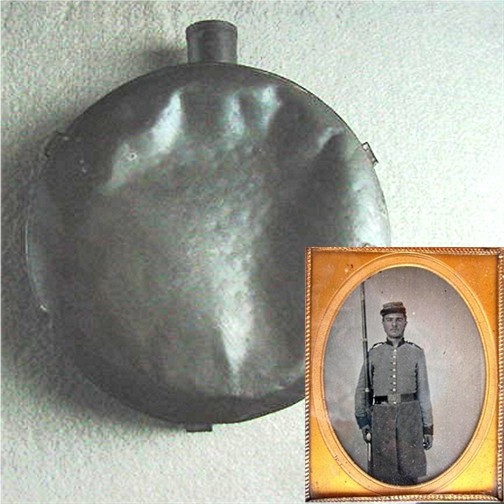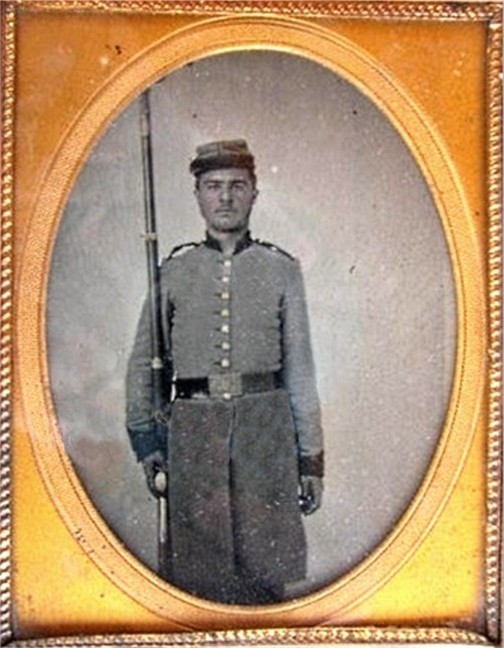|
IDENTIFIED CONFEDERATE TIN DRUM CANTEEN –
LOUISIANA CSA ARTILLERYMAN – CORPORAL JOHN K. RENAUD,
FENNER’S BATTERY, LOUISIANA LIGHT ARTILLERY – SERVED
THROUGH THE ENTIRE WAR – 1861 TO 1865: This
classic Confederate Army Tin Drum Canteen is identified
to John K. Renaud, a Louisiana veteran of the Civil War
who served through the entire war, and fortunately
survived to live a full and active life into the 20TH
Century.

John Knight Renaud, born on May
26, 1843 in Port Gibson, Mississippi, had migrated to
Louisiana with his family by the time the storms of war
began to form. In 1861, at the age of 18, Renaud
enlisted in Company A of the Orleans Cadets in what was
the first mobilization of Louisiana men. Consisting of
several companies, the ranks of the Orleans Cadets,
especially those of Company A, were filled with young
men from the most prominent families of New Orleans –
the roster being a veritable list of “who’s who” in the
city’s social register – and the benefits of Renaud’s
association with this group would play out for the rest
of his life.
The Orleans Cadets moved to Virginia where Renaud’s
first commanding officer, Captain Charles D. Dreux – an
aristocrat from New Orleans society - was killed in a
skirmish on July 5, 1861 near Newport News, becoming the
first Confederate commissioned officer to be killed in
the war.
The Orleans Cadets continued to serve in Virginia until
May of 1862 at which time the battalion was disbanded
with many of the soldiers, including Renaud, joining
Captain Fenner’s Battery, Louisiana Light [horse drawn]
Artillery. Fenner’s Battery was assigned to the
Departments of Alabama, the Gulf, Louisiana,
Mississippi, and the West; and during the course of the
war was attached to Maxey’s Brigade, Loring’s Division,
French’s Division, Cantey’s Brigade, Stewart’s Division,
Eldridge’s Battalion, and Hoxton’s Battalion.
Renaud remained with Fenner’s Battery for the remainder
of the war, serving in action at the Jackson Siege, the
Chattanooga Siege, the Atlanta Campaign, Mill Creek Gap,
Rocky Face Ridge, Resaca, New Hope Church, the Atlanta
Siege, Nashville, and Mobile. Although he was one of
the younger soldiers in the battery, Renaud was promoted
to corporal. His service ended with his surrender and
parole at Meridian, Mississippi in May of 1865.
Renaud returned to New Orleans where he pursued a life
active in business, civic leadership, and becoming well
known in competitive shooting sports, competing at
Creedmoor and Frogmoor. Renaud owned retail and
wholesale grocery businesses, and served as the
superintendent of the New Orleans Department of Public
Works. He also continued his association with his
former comrades in arms, and served on the board of the
Soldiers’ Home in New Orleans.
Renaud’s Civil War service, in particular his early
enlistment in the Orleans Cadets, made him somewhat of a
celebrity in the years that followed the war, evidenced
by his appearance in periodic newspaper articles
featuring the service of the Cadets.
One of the fascinating benefits of researching pieces
such as this canteen is how the research reveals the
serendipitous intersections of people and circumstances
as events unfold. Long after the conflict had ended,
history was not yet ready to release Renaud from his
responsibility and service to the Confederacy.
While traveling on the Mississippi River in 1889, former
president of the Confederacy Jefferson Davis fell ill
and as his condition worsened, he was disembarked in New
Orleans and taken to the home of an Associate Justice of
the Louisiana Supreme Court, one Charles E. Fenner - the
very same Fenner who commanded the artillery battery in
which Renaud had served, and son-in-law of one of
Davis’s oldest friends. President Davis remained in the
Fenner home, lasting but two more weeks before
succumbing to his illness, and he was buried in New
Orleans. Given Renaud’s stature in the community and
his history of service with Fenner, it is very likely
that Renaud joined those maintaining a vigil at the
bedside of the dying president and at the very least,
participated in the funeral processional.
In 1893, after much discussion throughout the nation,
Davis’s widow decided to remove him to the Hollywood
Cemetery in Richmond, Virginia. The State of Louisiana
provided an honor guard – including Renaud - to
accompany the president’s remains on the train to
Richmond, and upon arrival, Renaud led the contingent of
handpicked Louisiana Confederate Veterans as they
marched in the president’s last processional.
Renaud continued to be a local celebrity well into the
20TH Century, regularly appearing in various
news articles covering various memorials to the
Confederate cause. John K. Renaud passed away in 1926
in his beloved New Orleans, and he is buried in the Army
of Tennessee Tomb in the Metairie Cemetery.

Corporal Renaud’s Canteen
originally passed into the collector’s market paired
with the ambrotype shown in the photographs below, which
captured a young Renaud in his Confederate uniform.
Unfortunately, the image and canteen were separated with
a sale of the image, but with the assistance of a
previous owner, I was able to obtain a digital copy of
the image to include with this sale. I suspect the
image was made after Renaud transferred from the Orleans
Cadets to Fenner’s Battery as an image of the Orleans
Cadets made in 1861 shows that their uniforms did not
have the dark collar and cuff trim that is present on
the uniform coat Renaud is wearing in this image. The
dark trim is likely red in keeping with the uniform trim
appropriate for an artilleryman.
Despite showing signs of having been carried in the
field and subjected to the normal wear of a soldier on
campaign, Renaud obviously cherished his canteen as a
record of his service with Fenner’s Battery. He hand
engraved his name, the unit’s name, and his state in
several places on both sides of the canteen.
The majority of the engravings are fully legible,
however due to the fine tip stylus Renaud used, most of
the engravings are easier to see in proper light or when
the canteen is held at an angle. I have included close
up photographs below with the text of the engravings
highlighted with the addition of colored block letters
below each line of engraving. There are a few words I
could not decipher, but perhaps a clearer eye and a
steadier hand holding the magnifying glass may yet be
able to make sense of those.
There is one date – April 24TH, 1865 –
engraved on one side of the canteen. While the
battery’s history is fairly detailed, I have been unable
to determine the exact significance of the date. On the
11TH of April, 1865, the battery departed
Mobile and was eventually routed to Meridian where it
surrendered on May 8TH. It could be that the
date was particularly significant to Renaud rather than
the entire unit.
Presenting as a classic Confederate Tin Drum Canteen, it
measures 6 ¼” in diameter and 1 5/8” deep, and is fitted
with three tin sling standing loops. The tin spout is
still intact and full form, all of the seams are still
fully intact, and there are no holes or splits.
One side of the canteen is flat as it was manufactured,
and the other slightly domed, with the domed side having
been pushed in. I am fairly certain that Renaud did
this intentionally in order that the canteen would hang
flat against his hip. Often seen on Civil War and
Indian War era canteens, the soldiers did this
intentionally in order that the canteen would hang flat
against their hip, rather than bounce around on the
originally manufactured rounded surface – an easy fix
for what was obviously an irritation to the soldiers.
Remnants of the original linen sling remain with the
canteen, the fragments now glued down to the tin to
prevent the loss of what remains. Before you cringe too
hard over the fragments being glued to the canteen,
consider that had some previous owner – perhaps Renaud
himself – not done this, none of the sling would have
survived with the canteen. As it is, we can see what
the original sling looked like and how it was made, and
that is valuable information. Finally, while the
stopper still survives with the canteen, it survives
inside having been pushed or fallen through the spout.
I made some effort to retrieve it, and it probably can
be done, but I’m going to leave that to the next owner.
A detailed folio of biographical information will
accompany the sale of this canteen. The folio includes
Renaud family historical and genealogical information,
copies of photographs taken during the course of
Renaud’s life, outlines of his service record, copies of
newspaper articles covering Renaud’s civic
participation, attendance at memorials – to include
Jefferson Davis’s funeral, and his shooting
competitions, and his obituary, as well as detailed
histories of the Orleans Cadets and Fenner’s Battery.
This is an especially nice Confederate Tin Drum Canteen
in its own right. The added value of surviving with the
detailed soldier-applied identifiers Corporal John K.
Renaud engraved on the faces of the canteen, and even
more so, that he was a member of a well fought Louisiana
Light Artillery Battery, all combine to elevate this
Confederate Canteen a very special collectible of the
quality that seldom appears on the open market. (0107)
$1950
|

